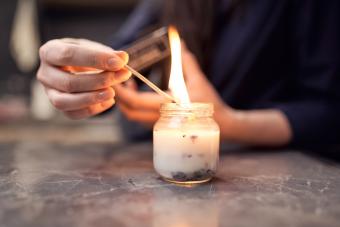
Hydrogen peroxide can be very effective in killing viruses and germs that commonly form in your home. It's most effective used in commercially available products combined with other germ-killing substances, or in a home DIY treatment combined with white vinegar.
Using Hydrogen Peroxide
Hydrogen peroxide (H2O2) is typically found as over-the-counter medication at pharmacies and stores in a three and six percent solution with water. This is because hydrogen peroxide in its fully concentrated form is way too strong for household use and in fact is used as a propellant in rocketry and as a bleaching and corrosive agent in manufacturing facilities. Hydrogen peroxide is highly reactive and works on germs through oxidation. This process occurs when the reactive oxygen atoms interfere with the electrons of other cells, which causes the walls of the cells forming bacteria to break down.
Effectiveness of Hydrogen Peroxide as a Disinfectant
Hydrogen peroxide is regularly used for sterilizing medical equipment and surfaces and is favored as a disinfectant over bleach because it eventually degrades safely into a non-toxic mix of water and oxygen. Cleaners that contain hydrogen peroxide are recommended for killing viruses and pathogens such as those that cause the flu, H1N1 and oral streptococci. The Centers for Disease Control says 3% hydrogen peroxide "is a stable and effective disinfectant when used on inanimate surfaces." Research has also found it to be effective in disinfecting fabrics used in hospitals such as bed sheets and surgical equipment.
Disinfecting With Hydrogen Peroxide
Hydrogen peroxide can be used to disinfect against many types of germs such as "vegetative bacteria, yeasts, viruses including norovirus, spores and fungi." It is typically used on hard, non-porous surfaces such as counters and tables and some types of medical equipment. It does tend to kill bacteria slower than other disinfectants such as bleach and it's safest to allow up to 30 minutes after disinfecting to consider an area "cleaned." However, using professional cleaners that use hydrogen peroxide as an ingredient along with other substances, such as Clorox Hydrogen Peroxide Cleaner and Lysol Cleaner with Hydrogen Peroxide (Citrus Sparkle Zest) can kill bacteria and viruses as quickly as 30 to 60 seconds. Products like these that contain hydrogen peroxide are also included on the Center for Biocide Chemistries' list of agents that are effective against the COVID-19 Coronavirus.
Using Hydrogen Peroxide With Vinegar
A commonly recommended household DIY disinfectant is a solution of 50% hydrogen peroxide (3% solution) and 50% distilled white vinegar (5% acetic acid). While they can be more effective together as a disinfectant, you should actually not mix them but use them in tandem.
- Place the vinegar in a spray bottle and add a spray nozzle to a bottle of hydrogen peroxide.
- Clean the area first thoroughly, and then spray with surface with either vinegar or hydrogen peroxide and wait five minutes, then wipe clean with a cloth.
- Then repeat this process with whichever one you did not use first.
Surfaces That Cannot Take Hydrogen Peroxide
Because of hydrogen peroxide's chemical qualities, there are some surfaces and materials that will be damaged with its use. Do not use hydrogen peroxide on anything made of:
- Aluminum
- Brass
- Copper
- Galvanized steel
- Natural stone
- Plastic that is porous
- Rubber
- Silver
- Wood
- Zinc
It's also important to test out a bit of hydrogen peroxide on a surface first if you have concerns. It has been known to discolor some surfaces, even ones that it is safe on, so it's best to do a quick test before applying it all over.
Shelf Life of Hydrogen Peroxide
One concern about using hydrogen peroxide as an effective disinfectant is that you must store it properly. Hydrogen peroxide will break down if exposed to light, which is why you find it in the pharmacy in dark plastic bottles. Make sure that you store your hydrogen peroxide in a cool, dry place and its potency should remain stable for the long term.
Remember to Clean First!
One important step in using any product to disinfect your home is that these products are most effective when used after you have cleaned. This means using a hot water and soap solution to clean all of your surfaces as well as fabrics first. Once this step is completed, then you should add in disinfecting for a one-two punch to harmful bacteria and germs.
Clean and Disinfect Your Home With Hydrogen Peroxide
Hydrogen peroxide has definitely been found to effective in disinfecting surfaces and killing harmful pathogens. It's also environmentally friendly compared to other strong cleaners like bleach. If you choose to use hydrogen peroxide for illness prevention, make sure you include a thorough cleaning first and combine it with the use of white vinegar for the best chance of destroying bacteria that can lead to illnesses like the Coronavirus and the flu.







